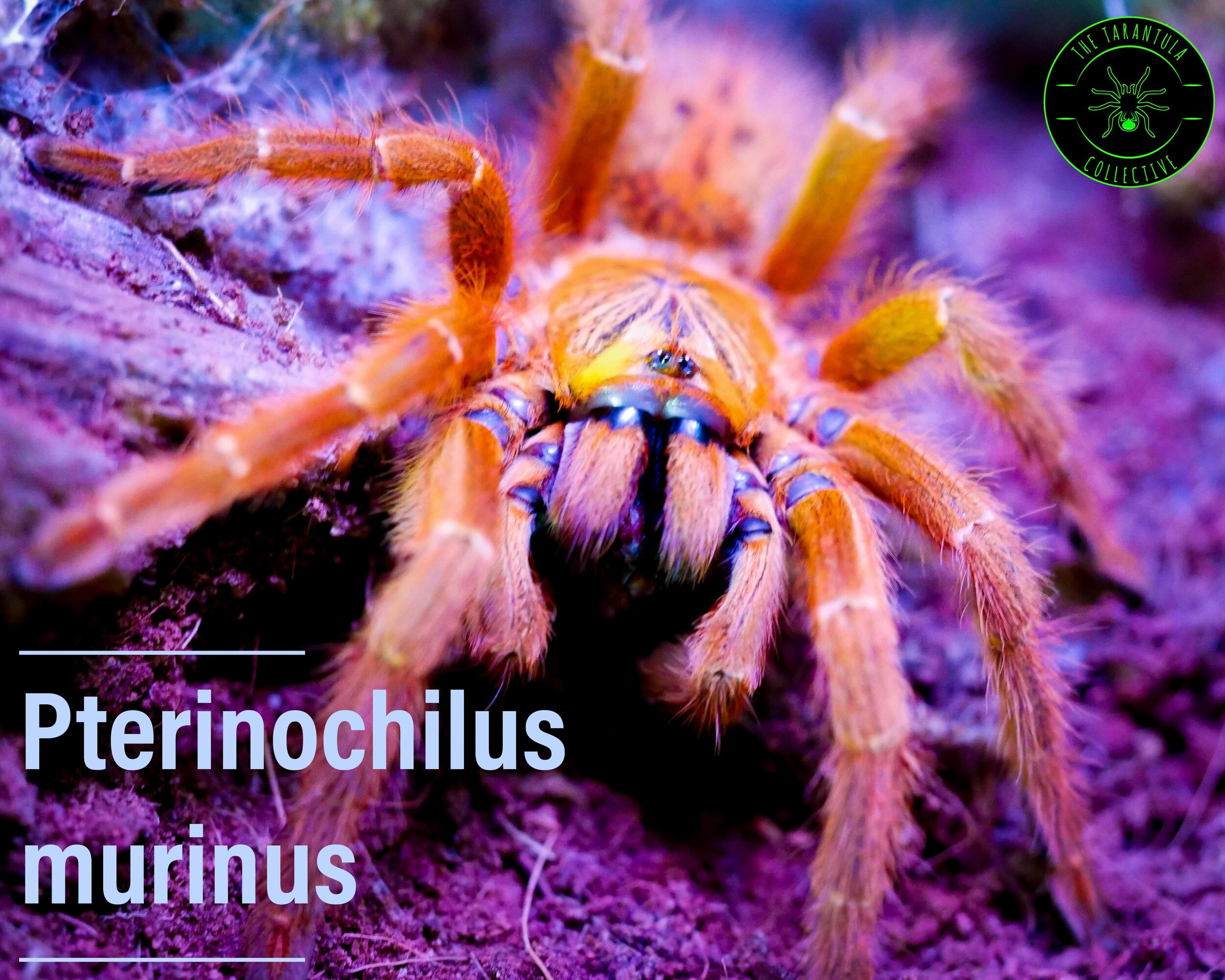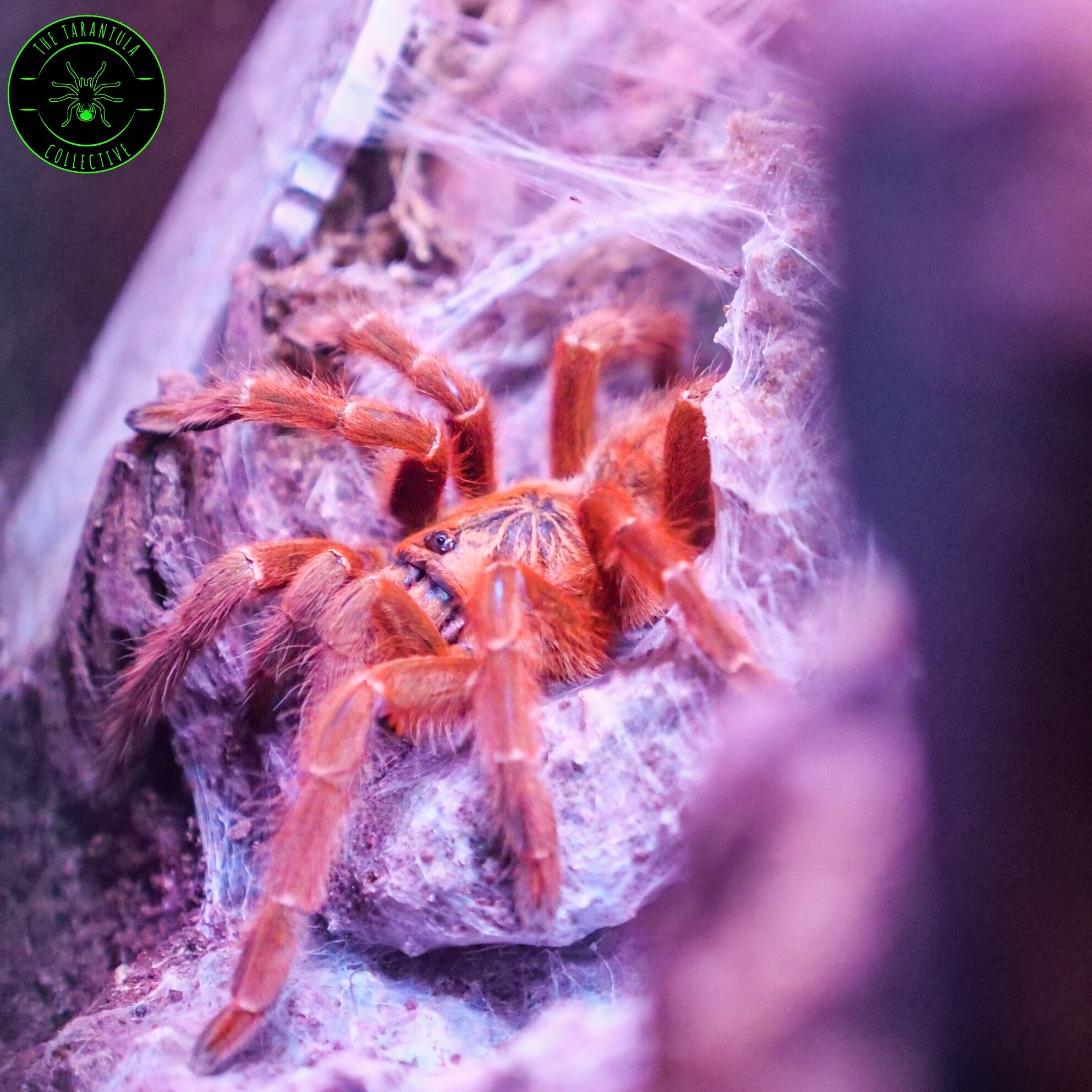Orange Baboon Tarantula
Pterinochilus murinus
Care Sheet
Orange Baboon Tarantula Care
Pterinochilus murinus Care Guide
The Orange Baboon Tarantula
(OBT, Mombasa Golden Starburst, Usambara Baboon, Orange Bitey Thing)
Revision Date: March 2025
Introduction
Pterinochilus murinus, commonly known as the Orange Baboon Tarantula (or OBT), is a striking Old World species famous for its brilliant orange coloration and notorious defensive temperament. Native to various countries in central and southern Africa, including Angola, Burundi, Congo, Kenya, Malawi, Tanzania, Zambia, and Zimbabwe, this tarantula is technically terrestrial but often displays semi‑arboreal behaviors in captivity. Due to its speed, aggression, and medically significant venom, it is best suited for advanced keepers who can provide a secure, well‑designed enclosure.
Quick Species Snapshot
Scientific Name: Pterinochilus murinus
Common Names: Orange Baboon Tarantula, OBT, Mombasa Golden Starburst Tarantula, Usambara Baboon, Orange Bitey Thing, Pterror
Type: Terrestrial / Semi‑arboreal
Category: Old World
Endemic Location: Angola, Burundi, Congo, Kenya, Malawi, Tanzania, Zambia, Zimbabwe
Body Length: Approximately 2.25” (6 cm)
Diagonal Leg Span (DLS): Approximately 6” (15 cm)
Urticating Hairs: No
Growth Rate: Fast
Life Expectancy:
Females: ~14 years
Males: ~4 years
Recommended Experience Level: Advanced
What Makes Pterinochilus murinus So Special?
The Orange Baboon Tarantula is known for its vibrant orange coloration and aggressive temperament, earning it nicknames such as “Orange Bitey Thing.” Its speed and defensiveness, along with its potent venom, make it one of the most challenging and exciting species in the hobby. While it is technically terrestrial, in captivity it often exhibits semi‑arboreal tendencies by climbing on provided structures. Due to its high activity level and escape artist nature, careful enclosure design and strict handling precautions are essential.
Natural Habitat & Enclosure Considerations
In the wild, P. murinus inhabits arid to semi‑arid regions with sparse vegetation and rocky substrates. In captivity, replicating these conditions means providing an enclosure that allows both burrowing and some climbing for web anchoring, but never an arboreal setup. The general rule of thumb is that the enclosure should be no smaller than three times the tarantula’s leg span. For spiderlings, this is the bare minimum; juveniles benefit from 3–4 times their leg span, while adults ideally have 3–5 times their leg span. Remember, tarantulas typically remain near their burrows, so while more space can encourage natural movement, an overly large enclosure can pose escape risks if ventilation holes or gaps are too big.
Housing & Substrate – Semi-Arboreal Setup
Note: "Semi-arboreal" is not an official behavioral classification but rather a descriptive term used in the hobby to design enclosures that allow a tarantula to display some climbing and web anchoring behavior without exposing it to dangerous falls. For semi-arboreal species (e.g., Monocentropus balfouri, Green Bottle Blue Tarantula, Dolichothele diamantinensis, Pamphobetus sp., and Cyriocosmus species), the enclosure is typically a square or horizontal rectangle rather than a tall arboreal setup. This design minimizes fall distance and risk of injury. Never use an arboreal enclosure for a species that is not truly arboreal.
Spiderlings
Enclosure Size: Use a small enclosure (e.g., Sling Crib, 3" Tarantula Cube, Small Slider Crib, Small Cuboid, Terrestrial Sling Crib, Slider Crib Mini, or Cuboid Mini) that is at least 3× the tarantula’s leg span.
Substrate: Fill at least 2/3rds of the enclosure with Terra Aranea by The Bio Dude.
Humidity: Maintain a slightly damp substrate (but not swampy) by offering a small water dish or gently dripping water on one corner about once a week.
Juveniles
Enclosure Size: Use a medium enclosure (such as a Medium Slider Crib, 6" or 8" Tarantula Cube, or Medium Cuboid) that is at least 3–4× the tarantula’s leg span.
Substrate: Fill the enclosure half full with Terra Aranea by The Bio Dude. This setup provides ample depth for burrowing while minimizing the risk of injury from falls.
Humidity: Keep the substrate mostly dry with a full water dish; you can occasionally overflow one corner to create a slightly damp area.
Additional Features: Provide a half cork bark round for a secure hide and include vertical branches, cork bark pieces, or plants to serve as web anchors, encouraging the tarantula to build natural web tunnels.
Adults
Enclosure Size: Use a large enclosure (such as a Large Slider Crib, 12" Cube, 18" Cube, or Terrestrial XL) that is at least 3× the tarantula’s leg span—ideally 4–5× for enhanced natural behavior, though too much space may increase escape risk.
Substrate: Fill the enclosure half full with Terra Aranea by The Bio Dude to provide sufficient depth for burrowing while minimizing fall distance.
Additional Features: Include a secure hide (ideally a half cork bark round), a shallow water dish, and tasteful decorations. Ensure the enclosure is a horizontal rectangle (wider than it is deep) with secure ventilation and a tight lid to prevent escapes.
Note: Consider using Tarantula Cribs with the affiliate code TTC10 to save 10% on your enclosure purchases.
Temperature & Humidity
Temperature: Maintain ambient temperatures between 68°F and 76°F (20°C to 24°C).
Humidity: Aim for moderate humidity. Ensure that the substrate remains moist in the lower layers for effective burrowing while allowing the upper layers to dry between waterings to prevent mold.
Feeding Schedule
Spiderlings
Frequency:
Feed twice a week.Prey:
Offer small prey such as flightless fruit flies, confused flour beetles, or pre-killed tiny crickets/roach nymphs. Remove any uneaten prey after 24 hours. increase the size of the prey as the spider grows. Prekill any prey that is over 2/3 the size of the sling. For more detailed information on feeding spiderlings, watch this video: How To Feed Spiderlings & Scorplings (Baby Tarantulas & Scorpions)Post-Molt:
Wait 24–48 hours after a molt before feeding. Ensure that the tarantula’s fangs are solid black and its exoskeleton is not soft or shiny.
Juveniles
Frequency:
Feed every 7–10 days.Prey:
Provide 2–3 small to medium crickets or a medium Dubia roach.Feeding Guidelines:
If the abdomen is thinner than the widest part of the carapace, feed more prey more often.
If the abdomen is wider than the carapace, feed less prey, less often.
This strategy helps prevent obesity, which can lead to molting complications or increase the risk of an abdomen rupture from even a small fall.
Post-Molt:
Wait 3–7 days after a molt before feeding, ensuring that the tarantula’s fangs are solid black and its exoskeleton is fully hardened.
Adults
Frequency:
Feed every 2–3 weeks (or as needed).Prey:
Offer 4–5 large crickets or one large Dubia roach.Feeding Guidelines:
If the abdomen is thinner than the carapace’s widest part, increase feeding frequency.
If the abdomen is wider than the carapace, reduce feeding frequency.
This is crucial to avoid obesity, which can interfere with proper molting or cause dangerous issues such as an abdomen rupture.
Post-Molt:
Wait 5–10 days after a molt before feeding, ensuring that the tarantula’s fangs are solid black and its exoskeleton is fully hardened.
Behavior & Temperament
The Orange Baboon Tarantula is known for its vibrant coloration and bold, defensive nature. Despite its semi‑arboreal tendencies, climbing on provided branches or decorations, it remains primarily terrestrial. This species is fast, aggressive, and not suited for handling due to its potent venom and rapid escape responses. Keepers should use extreme caution during maintenance, wearing protective gear to avoid the risk of being bitten.
Breeding Pterinochilus murinus in Captivity
Breeding Pterinochilus murinus (Orange Baboon Tarantula, or OBT) can be both rewarding and challenging due to their defensive nature and specific environmental needs. This species is renowned for its vibrant orange coloration and is native to various regions in Africa.
Sexual Maturity & Pairing
Male Maturity: Males typically reach maturity within 1.5–2 years, developing longer legs and bulbous pedipalps for sperm transfer.
Female Maturity: Females generally mature around 2–3 years, achieving a robust size indicative of reproductive readiness.
Pre-Pairing Preparation: We should ensure the female is well-fed before introducing the male to minimize the risk of cannibalism. Slightly increasing humidity prior to pairing may encourage receptiveness.
Mating Process
Introduce the male into the female’s enclosure during the evening or nighttime when tarantulas are more active.
The male will typically perform courtship behaviors, such as tapping or drumming, to signal his presence.
If receptive, the female may respond similarly or remain still, allowing the male to approach and attempt copulation.
After successful mating, promptly remove the male to prevent potential aggression from the female.
Egg Sac Production
If fertilized, the female may produce an egg sac approximately 4–8 weeks after mating.
Maintain temperatures around 75–80°F (24–27°C) with humidity levels between 60–70%, ensuring adequate ventilation to prevent mold growth.
An egg sac can contain a substantial number of eggs, with reports indicating clutches ranging from 100 to 200 eggs.
Egg Sac Handling (Optional)
Some breeders choose to remove the egg sac from the female after 30–40 days for artificial incubation.
If left with the mother, spiderlings (slings) will typically emerge within 6–8 weeks and undergo their first molt to the second instar stage within 3–4 weeks thereafter.
Raising Spiderlings
P. murinus spiderlings exhibit a fast growth rate and require stable humidity with proper ventilation.
Provide enclosures with sufficient depth to accommodate their burrowing nature, including structures for climbing and web attachment.
Feed them appropriately sized prey, such as pinhead crickets or flightless fruit flies, every 2–3 days to support healthy development.
Challenges & Considerations
Temperament and Speed: P. murinus are known for their speed and defensive nature. Caution is advised during maintenance to prevent escapes or bites.
Humidity and Ventilation: Maintaining proper humidity levels is crucial, as spiderlings are particularly susceptible to desiccation. Ensure enclosures are well-ventilated to prevent mold growth.
Venom Potency: P. murinus possesses potent venom, and bites can cause significant pain and medical symptoms. Handling is not recommended.
Final Thoughts
Pterinochilus murinus (Orange Baboon Tarantula) is a dynamic and challenging species, best suited for advanced keepers. Its stunning orange hues, coupled with its aggressive and fast-moving nature, make it a standout addition to any collection. With proper husbandry, including a semi‑arboreal enclosure set up in a horizontal configuration, substrate filled half full to minimize fall risk, controlled humidity, and a balanced feeding routine based on abdomen size, you can maintain a healthy, vigorous specimen.
Additional Recommendations:
For enclosures, consider Tarantula Cribs with the affiliate code TTC10 for a 10% discount, and use Terra Aranea by The Bio Dude for substrate. For purchasing tarantulas and supplies online, check out Spider Shoppe (use code TTC10 for 10% off). Also, visit the Dealer & Discounts section on my website for a curated list of recommended dealers and discount codes.
Additional Scientific Information
Ecology & Habitat:
Pterinochilus murinus is native to a range of countries in central and southern Africa, thriving in arid to semi‑arid environments. In its natural habitat, it inhabits rocky terrain and scrublands where burrowing is essential for shelter and hunting.Defensive Behavior:
As an Old World tarantula, it lacks urticating hairs and instead relies on speed and a powerful bite as its primary defenses. Its venom, while not fatal to healthy humans, is medically significant and can cause considerable pain. This makes handling particularly risky.Enclosure Considerations:
Following the rule of thumb, always ensure that the enclosure is no smaller than three times the tarantula’s leg span for spiderlings, increasing to 3–4× for juveniles and 3–5× for adults. This minimizes the risk of injury from falls and helps simulate a natural environment. Semi‑arboreal setups, which offer both horizontal space and some climbing structures, work best for species like the Orange Baboon.Feeding & Health Management:
Overfeeding is a common issue; ensuring that the tarantula’s abdomen remains proportional to its carapace is essential. Feeding adjustments based on whether the abdomen is thinner or wider than the carapace are critical for preventing obesity, which can lead to molting complications or, in severe cases, an abdomen rupture.
(For further reading, consult recent studies in the Journal of Arachnology and ZooKeys for detailed taxonomic and ecological insights on Old World Theraphosidae.)
Finding GOLD SPIDERS & Eating GUINEA PIGS!
We found so many GOLD SPIDERS during day 7 of our tarantula expedition in Peru! We were outside Urubamba finding Hapalotremus, Urupelma, Ischnocolinae, Linothele and more! These gold tarantulas and spiders were beyond beautiful and it was a very EXCITING experience finding so many UNDESCRIBED species in the wild!
Top 10 BLUE Tarantulas - YOU Won't Believe Your Eyes!
We are getting BLUE in the Tarantula Collective! Join me this week as I count down MY PICKS for the TOP 10 Blue Tarantulas in the tarantula hobby! It has Old Worlds and New Worlds. Fossorial, terrestrial, and arboreal. It is an amazing show case of the BEST blue tarantulas in my collection.










